Avascular Necrosis, commonly known as AVN, refers to the death of bone tissue due to a lack of blood supply, leading to joint pain and potential complications.
Welcome to YKOrthopaedics.
Home / AVN Hip Treatment in Gorakhpur
Consult Dr Yugal Karkhur for AVN Hip Treatment in Gorakhpur
or an online consultation

Dr Yugal Karkhur is a pillar in the world of Orthopaedics & joint replacement with over ten years of invaluable service. His academic journey began at Maulana Azad Medical College, New Delhi, progressing to impactful roles at renowned institutions like Lok Nayak Hospital and Sushruta Trauma Centre. Presently, he’s elevating patient care as the Senior Consultant in Orthopaedics and Joint Replacement at Narayana Superspeciality Hospital, Gurugram. Expanding his horizons, he ventured to the Missouri Orthopaedic Institute, USA, for specialized training in joint replacement and Adult hip preservation. His skill set also includes arthroscopic surgeries, a craft honed at Safdarjung Hospital’s Sports Injury Center. Beyond individual care, Dr Yugal has in the past collaborated with Gurgaon’s elite medical institutions like CK Birla Hospital and plays an instrumental role as the co-founder of Orthocure Surgery+ at Orthocure Clinics Pvt Ltd. His dedication to research is underscored by 17 peer-reviewed publications and accolades like the Young Ambassador Award from the Asia Pacific Orthopaedic Association in 2016.
What is AVN Hip?
Avascular Necrosis of the Hip, also called as Osteonecrosis of the Hip, and is a painful condition that occurs when the blood supply to the Femur head (ball of the hip joint) is decreased or disrupted. Decreased blood supply will lead to untimely Destruction of Hip Joint leading to painful Arthritis of the Hip.
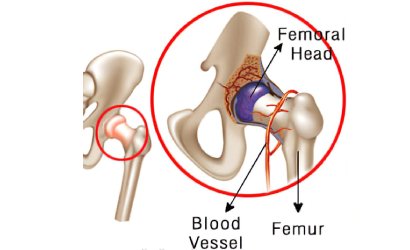
Source: medindia.net
How Common is the AVN Hip Problem?
In India, more than 16,000 new cases of AVN hip are reported each year, and is more common between 20-50 year olds.
What are the causes of AVN Hip?
Since the problem happens because of decreased blood flow to the Femur head, the causes are related to decreased blood supply.
The most common causes are:
- Too much alcohol
- Fracture of Hip joint
- Prolonged use of steroids
- Smoking
- COVID infection in the past
- Cancer (use of Chemotherapy)
- Sickle cell anemia
- After kidney transplant
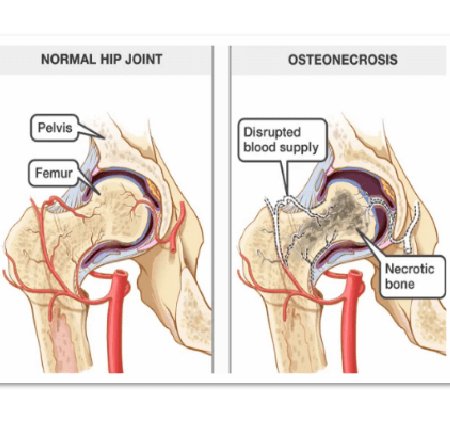
Source: avnclinics.com
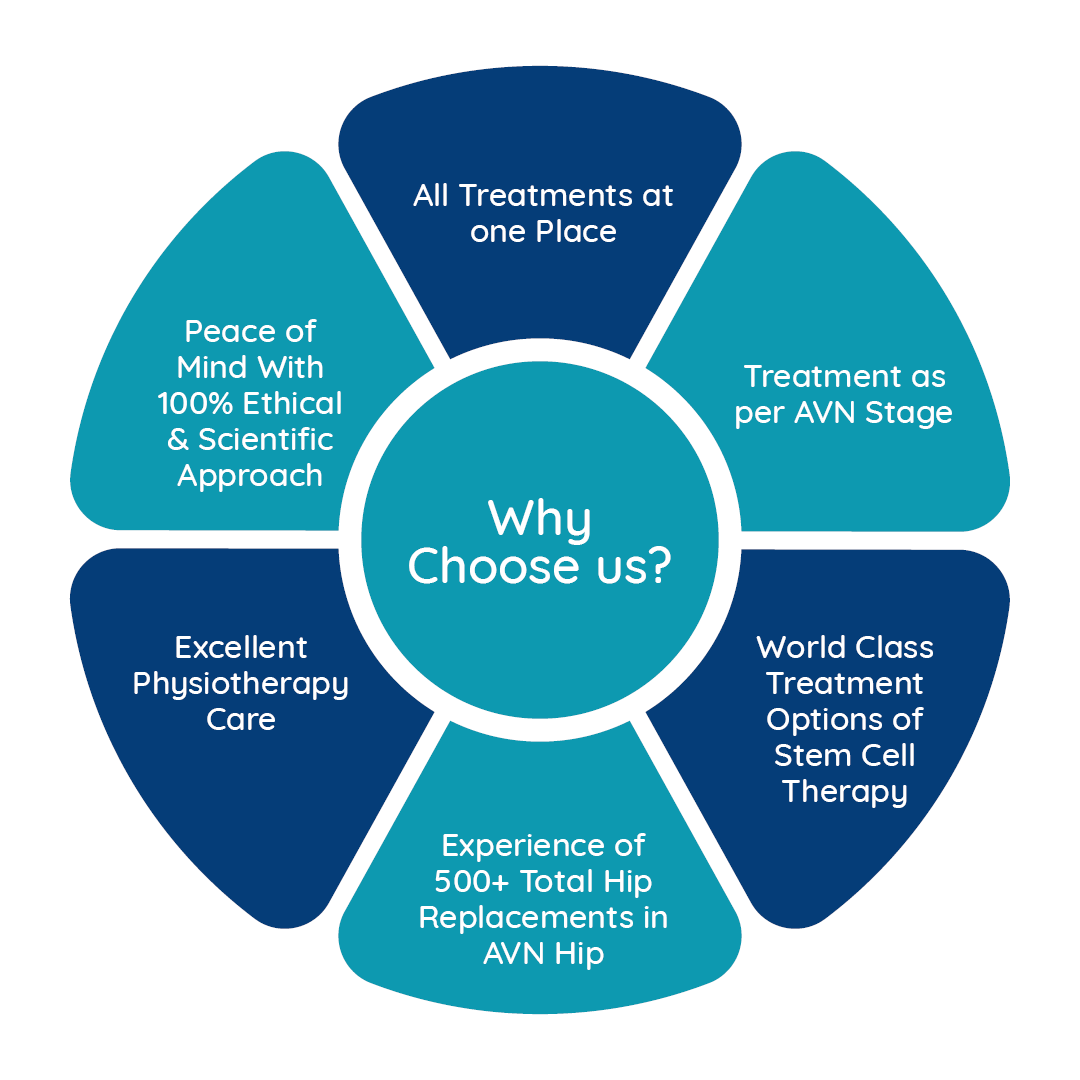
Why Opt for YKOrthopaedics for Your AVN Hip Treatment?
When it comes to Avascular Necrosis (AVN) treatment, YKOrthopaedics stands as an unparalleled choice for myriad reasons. First and foremost, we offer bespoke treatments tailored to each stage of AVN, ensuring optimal outcomes. Our world-class stem cell therapy options are at the forefront of medical innovation. With an impressive track record of over 500 total hip replacements specifically for AVN, our experience speaks for itself. Moreover, we provide comprehensive care under one roof, thus eliminating the need to shuttle between multiple facilities. Our physiotherapy care is second to none and complements our surgical treatments seamlessly. Most importantly, we uphold a 100% ethical and scientific approach, offering effective treatments and peace of mind.
What are the symptoms of AVN Hip?
The symptoms vary from Mild to Moderate to Severe
Mild Symptoms
- Pain in the front part of Hip/Joint
- Pain in the hip travelling to knee
- Pain increasing on walking
- Decreasing hip Movements
Moderate Symptoms
- Pain even as rest
- Difficulty in sitting on ground
- Difficulty in changing posture on bed
Severe Symptoms
- Limited hip movements
- Restricted achievements
What are the stages of AVN Hip?
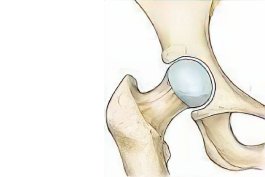
Stage 1:
Diagnosis from normal radiographs.
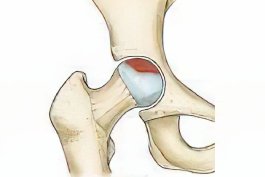
Stage 2:
Cystic changes and sclerosis visible on imaging.
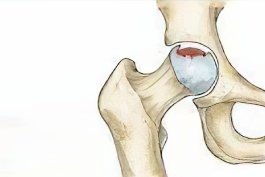
Stage 3:
Subchondral collapse or femoral head flattening
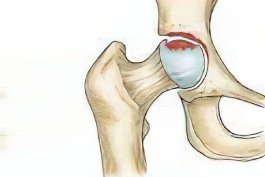
Stage 4:
Joint space
narrowing.
Image Source:- orthoinfo.aaos.org
How to prevent AVN Hip?
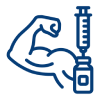
Limited use of steroids

Reduced Alcohol intake

Quit Smoking

Decrease Weight
Medical treatment ( in early stage)
(Stage 1 and 2)
Treatment options of AVN
Medicines
- Blood Thinners
- Bisphosphonate ( osteoporosis medicines)
- NSAIDS (Pain Killers)
- Lipid lowering agents
Regenerative Therapy
- PRP therapy
- Growth factor concentrate
- Stem cell therapy
Surgical Treatment
(stage 3 and 4)
Core decompression surgery with PRP injection
Total Hip Replacement
Have you been recommended to go in for AVN Hip Treatment?
Send your Reports for a FREE Expert Consultation
Advantages Of AVN Hip Treatment @YKOrthopaedics

Tailor made treatment plan

Surgery only if medical treatment fails
Use to Biological techniques
World Class Hip Replacement Techniques
Ceramic Hip Replacement for longer implant life
Commonly asked Questions Before AVN Hip Treatment
What is AVN Hip
treatment?
When can I walk hip surgery?

Can I squat & sit cross legged after surgery?

Can I run and cycle after surgery?
Can it increase my leg length?
FAQ’S
Various factors, including fractures, dislocations, excessive alcohol consumption, prolonged use of high-dose steroid medications, and certain medical conditions, can cause AVN.
AVN is typically diagnosed through physical examinations, patient history, and imaging tests like X-rays, MRI, or bone scans.
Early symptoms may include minor joint pain that intensifies over time, limited range of motion, and discomfort that becomes more pronounced with activity.
No, while both conditions affect the joints, AVN is caused by reduced blood flow to the bone, whereas osteoarthritis is a degenerative joint disease.
Yes, early stages of AVN can sometimes be managed with non-surgical treatments like medications, physical therapy, and lifestyle changes. However, advanced cases might require surgical intervention.
While not all cases are preventable, reducing risk factors like excessive alcohol intake, avoiding prolonged high-dose steroid use, and seeking timely treatment for joint injuries can help.
The progression of AVN varies among individuals. Many can lead a normal life with early detection and appropriate treatment, but in advanced cases, the condition can be chronic.
If left untreated, AVN can lead to severe joint pain, arthritis, and even joint collapse, necessitating joint replacement surgery.
Yes, maintaining a healthy weight, engaging in low-impact exercises, and avoiding activities that strain the affected joint excessively can help manage the condition.

